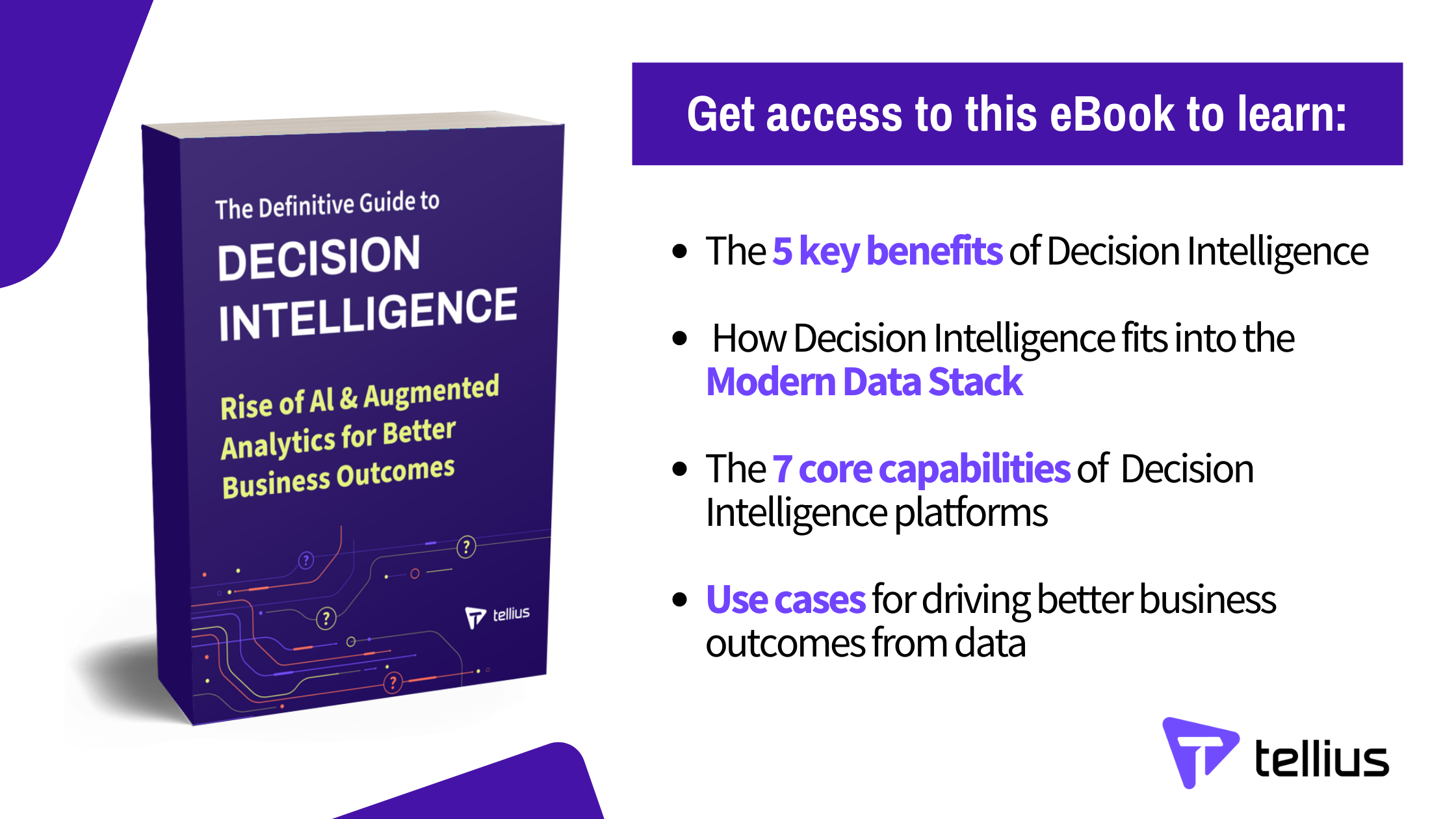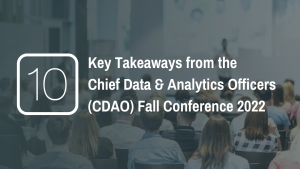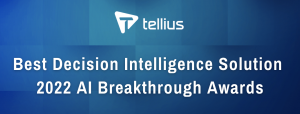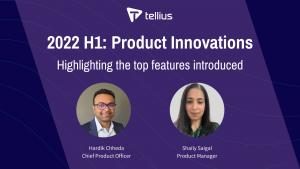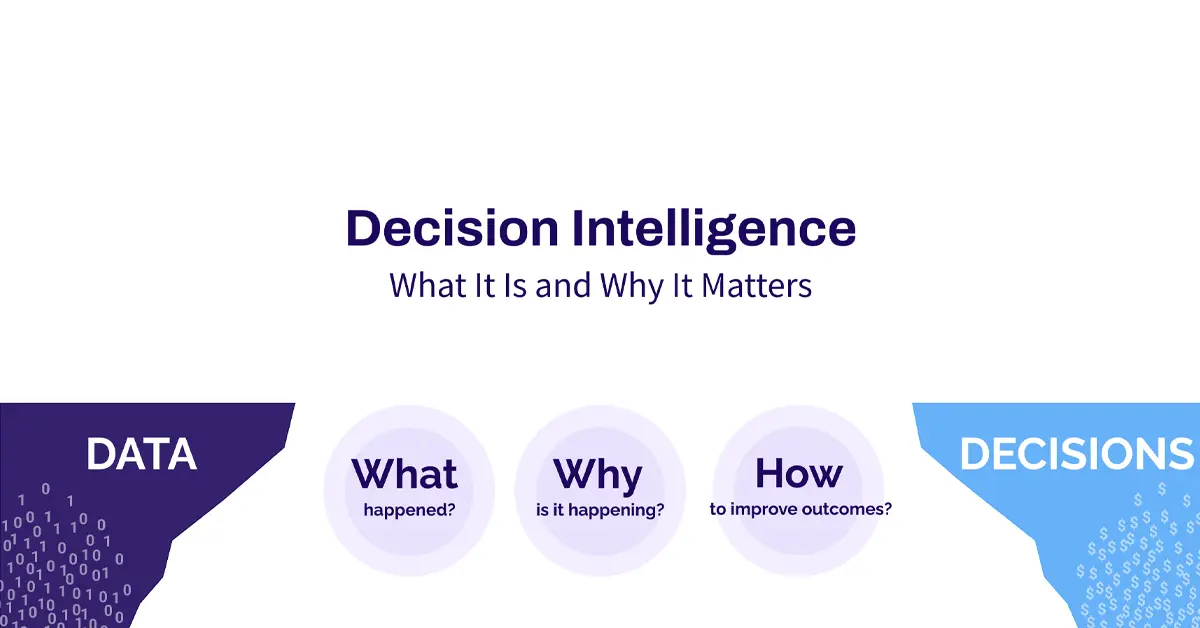
Introduction
Decision Intelligence has rocketed from obscurity to a Top Strategic Technology Trend for 2022 by Gartner, who predicts it will be practiced by 33% of large organizations by 2023. This technology is making data-driven decision making a reality for organizations of all shapes and sizes, unlocking access to advanced AI-powered analytics for every business user (even those without technical expertise). Business and analytics leaders should understand what Decision Intelligence is, why it matters, and how it can be beneficial.
In This Post
- Defining Decision Intelligence
- Why is Decision Intelligence Important?
- Benefits of Decision Intelligence
- Who is Decision Intelligence for?
- How does Decision Intelligence Improve Analytics Workflow?
- Core Capabilities of Decision Intelligence
- Decision Intelligence vs. Business Intelligence (BI)
- Decision Intelligence vs. Manual Analysis (SQL/ Python/Excel)
- Decision Intelligence vs. Data Science Tools
- Where does Decision Intelligence fit in the Modern Data Stack?
- Where Should Decision Intelligence Be Used?
- Decision Intelligence Use Cases
- Learn More about Decision Intelligence
Defining Decision Intelligence
Decision Intelligence is the application of Machine Learning and automation to augment human decision-making for better, faster insights-driven business decisions. To accomplish this, Decision Intelligence equips anyone to ask and answer what, why, and how-type questions of unaggregated data to drastically reduce the time and effort necessary to make strategic, tactical, and operational decisions.
Why is Decision Intelligence Important?
Data-driven enterprises that treat and use their data as an asset when it comes to understanding their customers and employees and making data-informed decisions — outperform competitors.
Businesses today have massive amounts of data and increasingly complex business decisions to solve with this data…but lack insights to bridge data to decisions. Just 24% of firms identify as data-driven and a mere 30% of a firm’s employees use analytics/BI tools. Analytical output (i.e., analysis, insights, data stories) don’t scale with data volumes because today’s tools, processes, and teams are siloed along the lines of descriptive, diagnostic, and predictive analytics, with time-consuming handoffs and insights gaps.
The result of this insights gap are inefficiencies (analytics ques, handoffs between teams and tools, etc.), missed opportunities (delaying decisions due to lack of analysis), and increased business risk (decision-making without robust analysis, or even worse, biased analysis).
Decision Intelligence offers a way to bridge this insights gap, helping users make better, faster, insights-driven decisions at cloud scale — with continuous improvement.
Benefits of Decision Intelligence
Bridging the gap unlocks better, faster, continuously improving insights-driven decisions:
- Bridging BI & AI: Break down internal silos within analytics functions to seamlessly iterate amongst diagnostic, predictive, and prescriptive analytics to get answers
- Enabling true self-service ad-hoc analytics: Turn analytics into a conversation with data, with the only prerequisite being curiosity (not coding or statistical acumen).
- Reducing the analytics backlog: Automate time-consuming or tedious aspects of analysis to get more done with less
- Supercharging analysis: Go deeper faster with AI, leapfrogging analysis (Ex. consider millions of data points and interaction combinations to automatically identify segments, drivers, cohort analysis, market share analysis, etc.)
- Democratizing predictive analytics: Put predictive analytics in the hands of commercial decision-makers (no longer reserved for the data science teams of technology supergiants)
Who is Decision Intelligence for?
Decision Intelligence is useful for business users, analysts, and data experts.
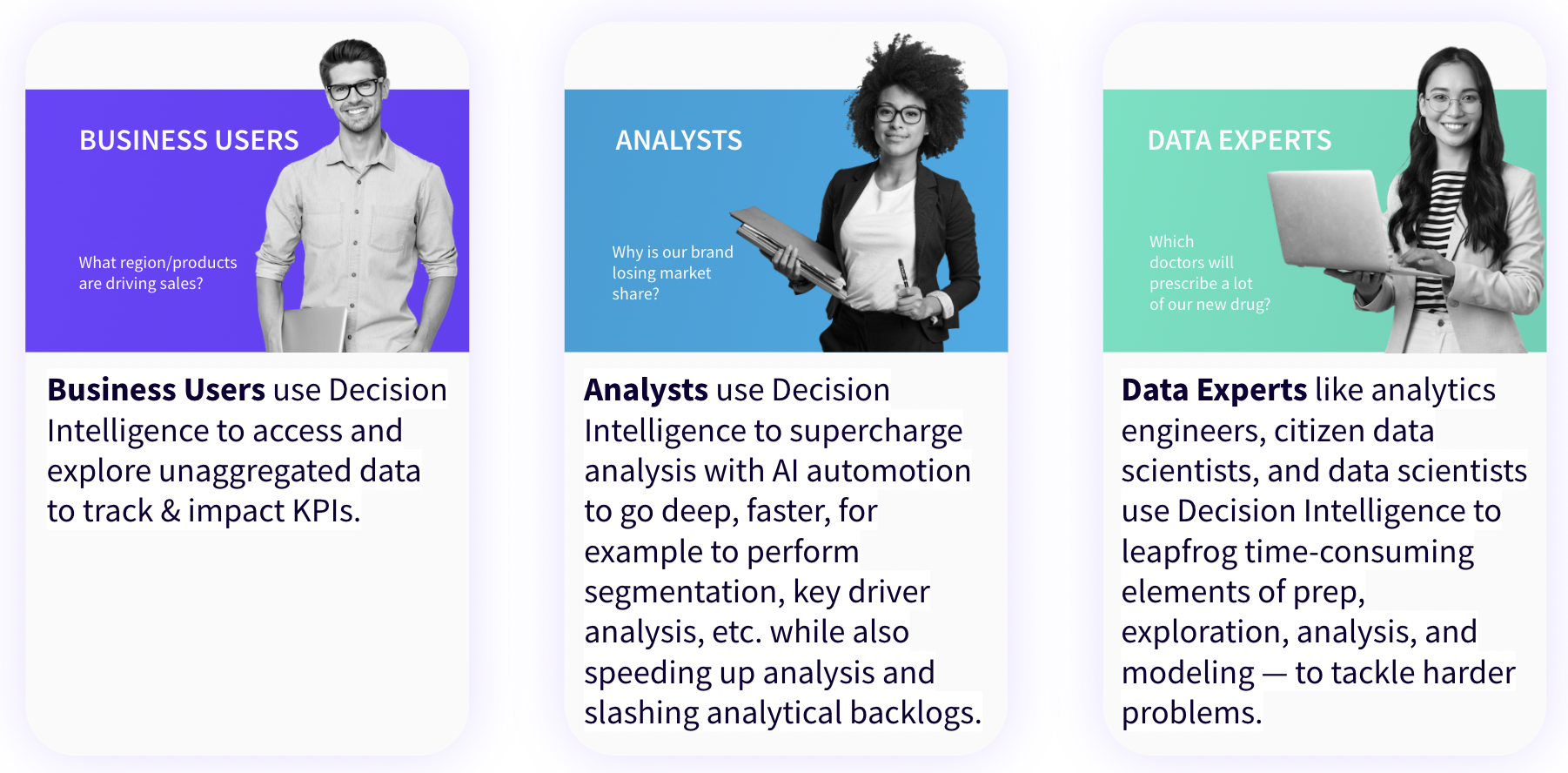
How does Decision Intelligence Improve Analytics Workflow?
Current analytics workflows are siloed along the lines of people, tools, and processes:
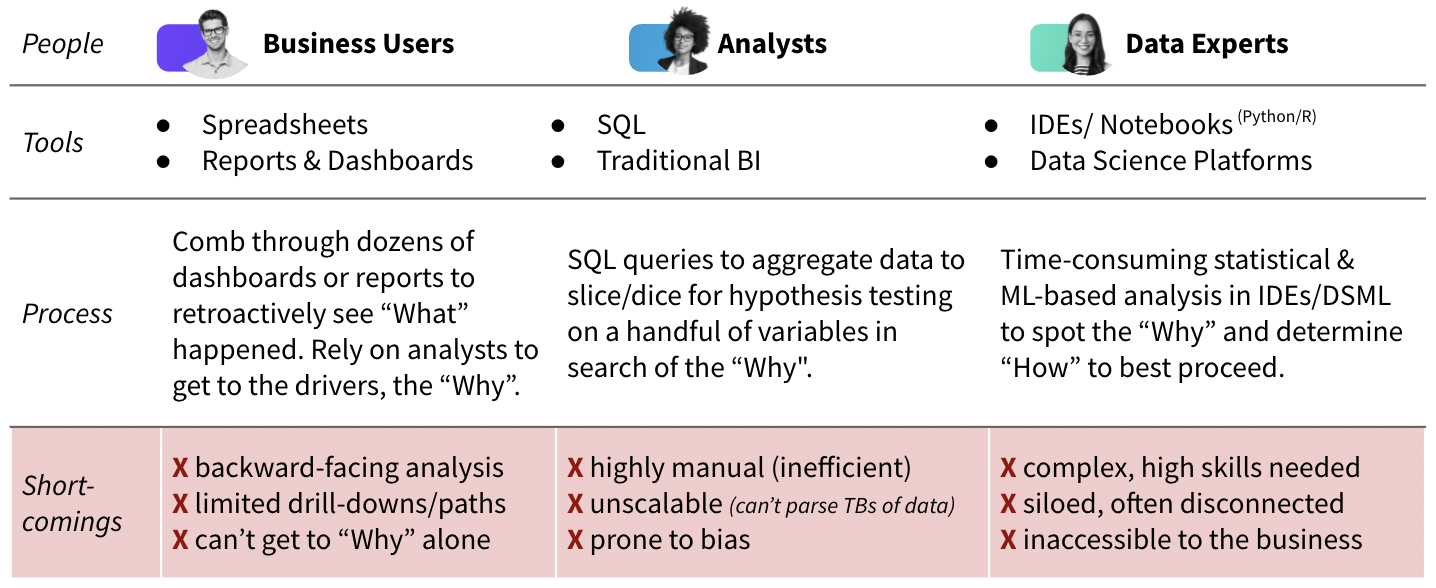
Decision Intelligence breaks down these artificial barriers in tools, processes, and teams, allowing anyone to quickly and collaboratively answer ‘what’, ‘why’, and ‘how’-type questions of their unaggregated data to ultimately make better decisions.
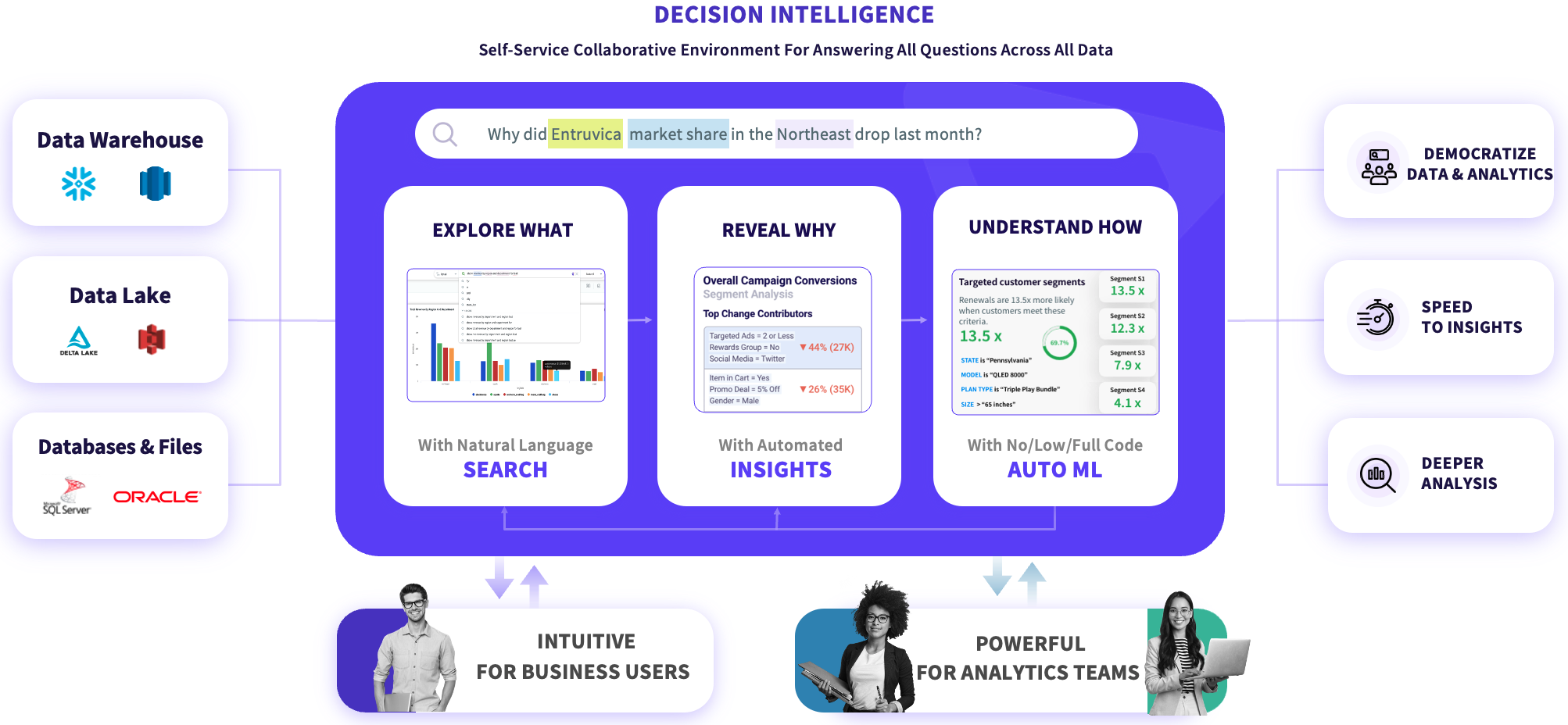
Core Capabilities of Decision Intelligence
Best-in-class Decision Intelligence platforms greatly simplify the complexity of decision making by translating business questions (in natural language), applying the right algorithms (statistical, classification, regression) in the most efficient way (in-memory or push down queries to where the data resides), and presenting answers back to users in an understandable and actionable format (using natural language generated narratives and embedding).

Connect & Model Data
Data is the bedrock underlying analysis and insights for better decisions. Best-in-class platforms offer:
- Connectivity to a variety of data sources in a variety of ways including cloud, on-prem, flat files, 3rd party (e.g., Nielsen, IQVIA, etc.), and business applications (e.g., Salesforce, Google Analytics, etc.) via point-and-click pre-built connectors or API – all with intelligent connectivity (zero-data movement to leading cloud sources).
- Augmented data modeling: Auto-inferring data models from source systems and suggesting the creation of business views within the platform and/or suggest join keys while creating reusable and foundational data models. Data models ensure data consumers are exploring the single source of truth and data creators are creating analytics outputs from trusted sources.
Data Prep and Pipelining
Modern insights-driven decisioning requires blending data, developing metrics/calculations, and flexibility to add new sources or metrics as analysis evolves. Best-in-class platforms feature:
- Point & click prep: Visual interface to blend and clean data including dozens of prebuilt context-specific steps, auto-inferred data models, and suggested joins.
- Code-based prep: In-app Python/SQL data prep support,reusable code snippet library, and automated code validation.
- Data pipeline: Visual data pipeline that automatically tracks all data prep steps for repeatability and auditability.
Natural Language Search (NLQ)
Data exploration and ad-hoc analysis is critical to decision making. Natural Language Query (NLQ) allows any user — regardless of data skills — to flexibly explore and analyze terabytes of unaggregated enterprise data in plain English, democratizing exploration and analysis by making it as simple/intuitive as a Google search. NLQ — coupled with automatic results visualization — reveals what is happening quickly. Best-in-class platforms feature:
- Accessible: Best-fit AutoViz search results, typo correction, synonyms, and display names
- Powerful: Universal search of all data across locations; kick-off machine learning jobs from search; dozens of on-the-fly calculations out of the box (e.g., market share, time slices, YoY growth, etc.)
- Transparent: Visibility into the SQL generated by the NLQ search, drill path navigation, detailed view of metrics and filters used for reproducibility of search results.
- Intelligent: Autocompletion; smart indexing; suggestions; search guides; personalization learned over time from user searches
Automated Insights
Automated Insights accelerate complex data analysis with AI-driven automation to identify the why behind the what and provide direction as to how to improve outcomes (e.g., which segments/relationships to leverage) by automating root cause analysis, analyzing key drivers, comparing cohorts, and identifying meaningful segments in data that go beyond first-order facts/drivers. Best-in-class platforms provide one-click insights with accompanying natural language generated (NLG) explanations out of the box, including:
- Cohort analysis that provides reasons for differences among values or cohorts (e.g., what attributes delineate high customer lifetime value customers vs. low ones?)
- Trend drivers that provide reasons for differences in metrics/KPI over time (e.g., why are sales declining quarter over quarter?)
- Segment drivers which use machine learning to identify key drivers (e.g., why is customer retention lower in Q4 vs. Q3?)
- Anomalies & outliers that automatically spot unexpected shifts in business (e.g., are there fraudulent transactions?)
Machine Learning Modeling (AutoML, Point & Click, Code)
Machine Learning modeling is important for modern business decision making. Predictive analytics take segments/relationships from Automated Insights to the next level by spotting future potential opportunities for improving outcomes. Best-in-class platforms support:
- Multiple modeling modes – for example, point & click ML modeling; automated ML modeling (AutoML); and code-based ML modeling (i.e., bring your own Python/SQL models)
- A variety of models OOTB – such as, regression (e.g., predict inventory levels, sales, etc.); classification (e.g., category identification); time series (e.g., revenue/demand forecasting); clustering (e.g., spotting lucrative/risky segments, patients, etc.); and recommender systems (e.g., based on past behavior, similarities, etc.)
- Business friendly/explainable models: This includes contextual explanations and model explainability so users (regardless of background) can understand/trust predictions to power decisions.
Intelligent Assistant / Mobile App
Questions sometimes arise on the go or in the boardroom. Best-in-class platforms offer:
- A mobile app: native iOS/Android apps for determining what, why, and how in one place
- An intelligent assistant: Conversational, in-app and embeddable chatbot where users type or speak questions in natural language and get answers/drill down into unaggregated enterprise data on the fly, in a context-aware way
Data Visualization / Dashboards/ Reporting
Communicating analysis/insights is critical to decision buy-in. Best-in-class platforms feature:
- Visualizations: dozens of chart types; automatic geocoding; easy customization
- Dashboards: drag and drop, easily compostable/shareable modern dashboarding
- Reporting: on-demand, scheduled, and push-based reports via email, text, Slack, etc.
Data Storytelling
Storytelling streamlines conveying complex analysis and insights to influence decisions. Best-in-class platforms feature Automated Data Storytelling — concise, decision-centric insights, visualizations, and NLG-based summaries to expedite decision making.
Embedding & APIs
Exploration, analysis, insights, and predictions must be available where work occurs to allow a broader set of users to act on decisions. Best-in-class platforms feature:
- Embedding: Simple, modular embedding capabilities of some or all DI modules ( NLQ, Viz, Automated Insights, Predict) within any external portal or application.
- APIs: Robust and flexible APIs allowing any DI module be called upon externally/programmatically. For example, an app calls the Predict API to retrieve ML-powered predictions or calls the NLQ API with results returned as JSON objects (for custom search and charting) rather than brittle image files
Intelligent Monitoring
Monitoring outcomes, knock-on effects, and key metrics is important for continuous decision improvement. Best-in-class platforms are:
- Proactive: Alert the right people at the right time about anomalies and key changes, 24/7
- Outlier Detection: Time series regression models to detect outliers and identify events of most significance (not simple threshold tracking)
- Personalized: Learns from implicit and explicit user feedback to show relevant content and identifies/presents a user’s commonly searched metrics
Scalability & Security
Decisioning that considers billions of data points requires a scalable, robust, high-speed analytics engine, a compute framework, and security/access controls to keep everyone safe. Best-in-class platforms feature:
- Dual analytics engine: Purpose-built engine handles subsecond ad hoc queries as well as ML/AI workloads, intelligently routing user queries to the most efficient engine & compute paradigm (in-memory, pushdown, or data lake modes)
- Security & access: SSO, user and group-level access; impersonation
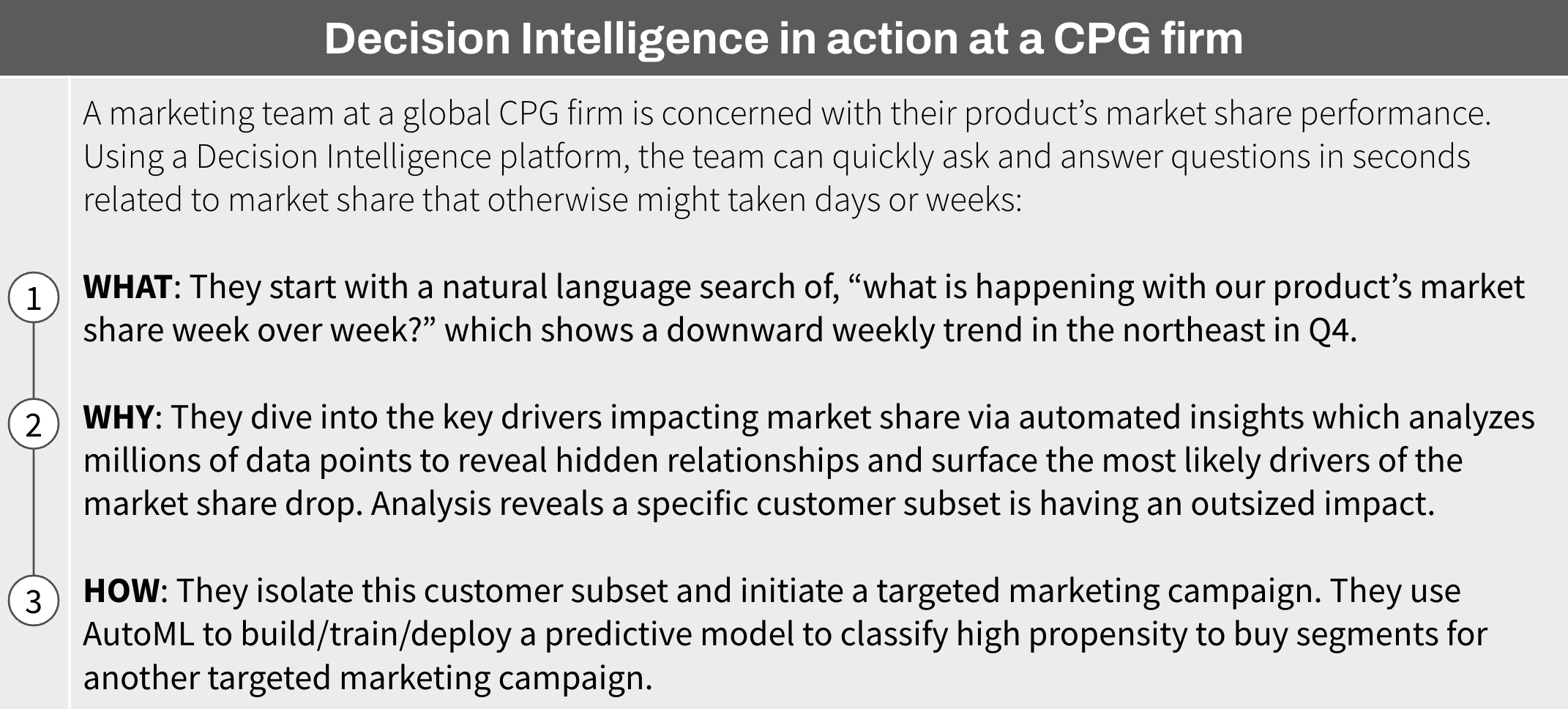
Decision Intelligence vs. Business Intelligence (BI)
Decision Intelligence differs from Business Intelligence (BI) in three key ways. First, BI is targeted for data consumers like business users, whereas Decision Intelligence is suited for both data consumers and analytics creators such as analysts and data experts. Second, BI is suited for descriptive analytics to answer which KPI or metric changed, whereas Decision Intelligence expedites identifying the “what”, the underlying “why”, and “how” to improve. Finally, BI lacks intelligent automation that Decision Intelligence does such as NLQ, automated visualizations, Automated Insights, Automated Prep, AutoML, and Proactive Intelligence.
Decision Intelligence vs. Manual Analysis (SQL/ Python/Excel)
Decision Intelligence differs from manual SQL/Python/Excel analysis in three key ways. First, manual analysis is primarily done by analytics creators like data analysts and data experts whereas Decision Intelligence is suited for data consumers like business users as well as analytics creators. Second, manual analysis is suited for diagnostic analytics to answer “why” KPIs changed whereas Decision Intelligence expedites identifying the “what”, the underlying “why”, and “how” to improve. Finally, manual analysis lacks intelligent automation that Decision Intelligence does such as NLQ, automated visualizations, automated insights, automated prep, AutoML, and proactive intelligence.
Decision Intelligence vs. Data Science Tools
Decision Intelligence differs from Data Science tools (DSML) in three key ways. First, DSML like manual analysis, is primarily in the purvey of analytics creators — typically advanced analytics creators like data scientists, whereas Decision Intelligence is suited for data consumers and analytics creators alike. Second, DSML is suited for predictive and prescriptive analytics to model the future and identify ways to improve outcomes, whereas Decision Intelligence expedites all forms of analytics (descriptive, diagnostic, predictive, and prescriptive). Finally, DSML tools are growing more in their automation in the form of AutoML but are still heavily manual like manual analysis and BI, whereas Decision Intelligence is marked by intelligent automation.
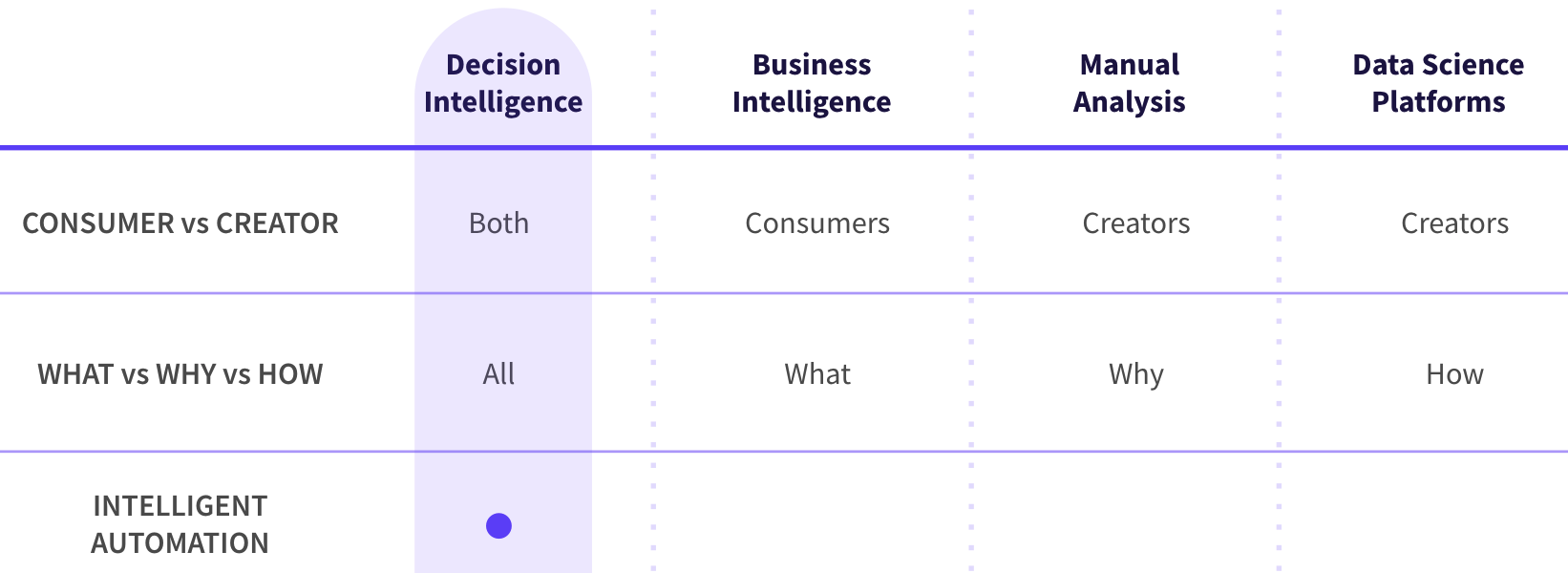
Where does Decision Intelligence fit in the Modern Data Stack?
The modern data stack (MDS) is a suite of tools for gathering, storing, transforming, and analyzing data, characterized by being built on cloud-first cloud data warehouses (cloud data warehouses are foundational to the MDS), having ease of setup/maintenance, and being flexible (pay-as-you-go pricing and modular mix-and-match of best-of-breed tools).
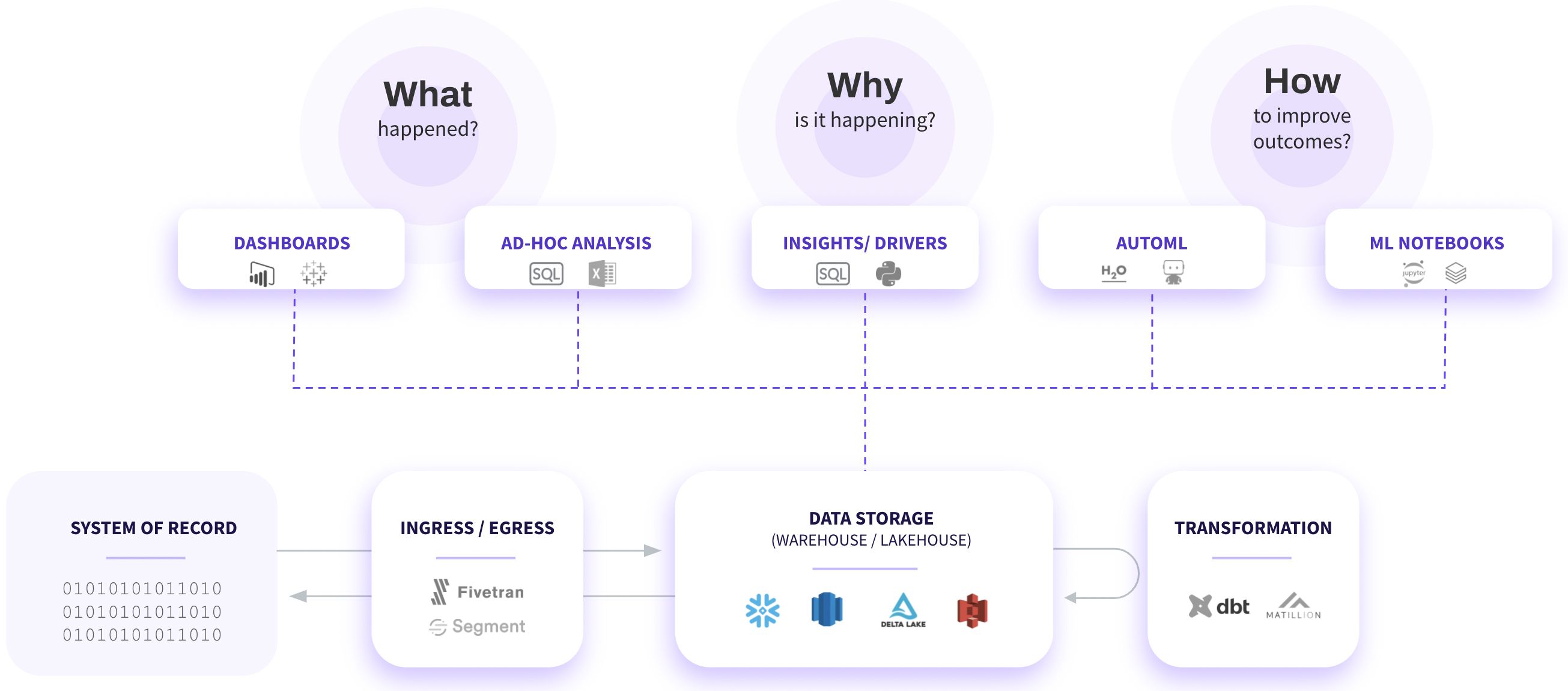
Decision Intelligence unifies the final layer of the modern data stack — the analytics layer — concerned with data exploration, analysis, and insights-generation. The analytics layer has remained stubbornly siloed around tools that can answer ‘what happened’ (dashboards, reports), ‘why it happened’ (manual hypothesis testing and SQL slicing), and ‘how to improve’ (manual analysis and IDEs/Data Science tools).
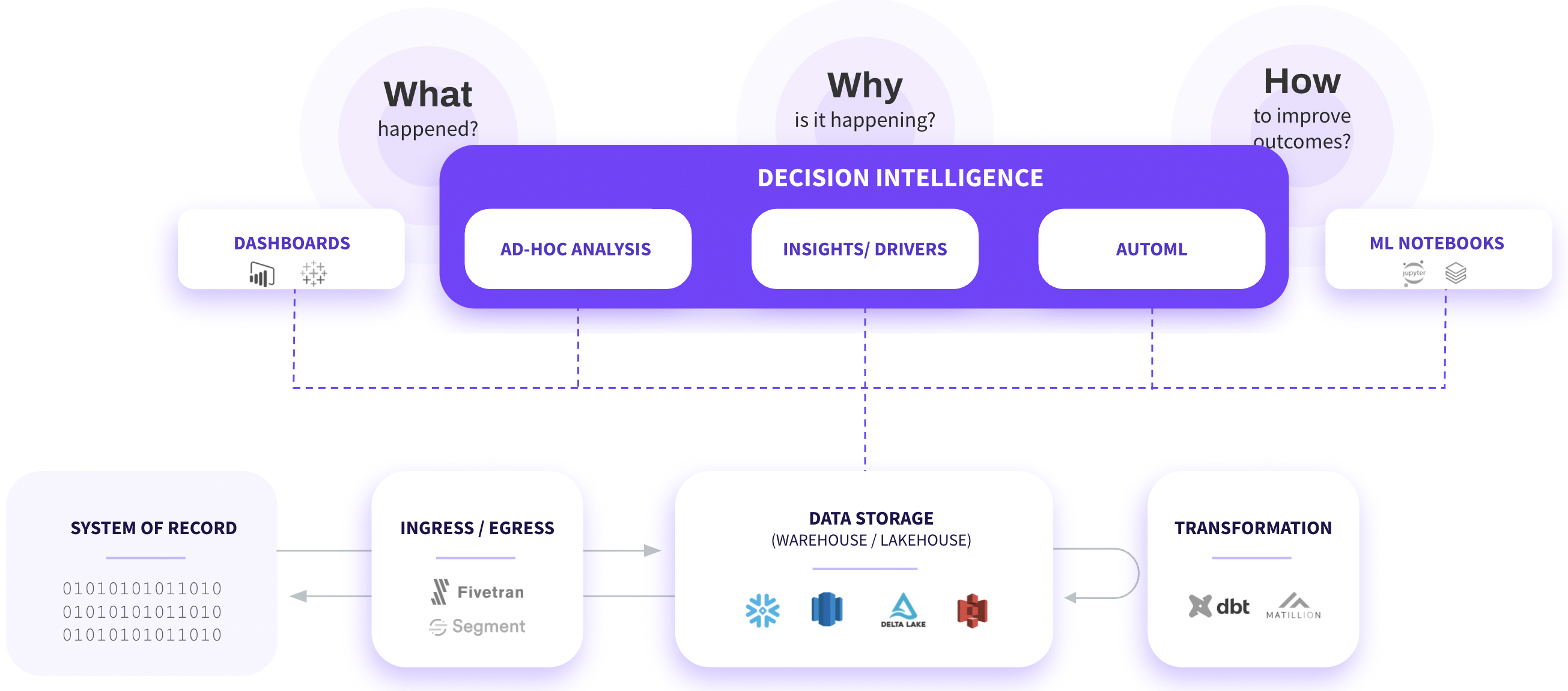
Where Should Decision Intelligence Be Used?
Decisions range immensely in type (strategic, tactical, operational), degree of machine involvement (decision support, decision augmentation, decision automation), and speed, scale, and complexity (low, medium, high).
- Analytics/BI is useful for decision support (i.e., 100% human made decisions) for strategic and tactical matters of low speed/scale/complexity.
- Data Science is useful for decision automation (i.e., 100% computer-made decisions) for tactical and operational matters of medium/high speed/scale/complexity.
- Decision Intelligence is useful for decision augmentation for strategic, tactical, and operational matters at both low/high speeds, scale, and complexity. It’s particular sweet spot revolves around decision augmentation – i.e., helping humans analyze millions of data points and see hidden connections that they otherwise would not have done, or serving up predictions and clusters that humans would not have otherwise seen.
Decision Intelligence Use Cases
Decision Intelligence is used across numerous industries and use cases, including:
INDUSTRY-AGNOSTIC
- Sales & Marketing: Brand Performance, Promotion/Incentive Optimization, Customer segmentation/ Customer 360o, CLTV, Market Share Insights, Ecommerce & Multichannel Analysis.
- Supply Chain Analytics: Automated Root Cause Analysis (of Defects, Delays, etc.), Inventory Management/Optimization, Demand Forecasting, Supplier Performance Monitoring, Quality Analytics
- HR Analytics: ad hoc analysis of HR metrics (headcount, attrition, salary, rewards, etc.)
- Gaming Analytics: Monetization, Game Experience/Design, Fraud Detection
- Pricing Analytics: Elasticities, Seasonality Pricing Optimization
INDUSTRY-SPECIFIC
-
- Communications: network management and optimization, capacity planning and forecasting, preventive maintenance
- CPG: Shopper Insights, capacity planning, promotion optimization
- eCommerce & Retail: Customer analysis, multi-channel, marketing analysis, operational and supply chain
- Financial Services: Credit Risk, Fraud Prediction, Rebate/Cash Flow Forecasting, Loan Analysis
- Insurance: policy underwriting, risk modeling, fraud detection
- Media: Ad pricing optimization
- Pharmaceuticals & Life Science: Patient Identification, Trial Enrollment Monitoring, Market Access, HCP targeting, Commercial Effectiveness, Rebate Operations
Learn More about Decision Intelligence
Tinace is an AI-Powered Decision Intelligence platform that enables data analysts and business teams to quickly understand reasons and key drivers for business behaviors, get instant answers using natural language, and simplify complex data analysis with machine learning automation. Tinace is disrupting the analytics market to give anyone, regardless of their analytical skills, granular insights into what is happening, why metrics change, and specific recommendations on how to impact business outcomes in a simple, unified user experience.
Check out our new Decision Intelligence eBook or try a 14-day risk-free trial today
